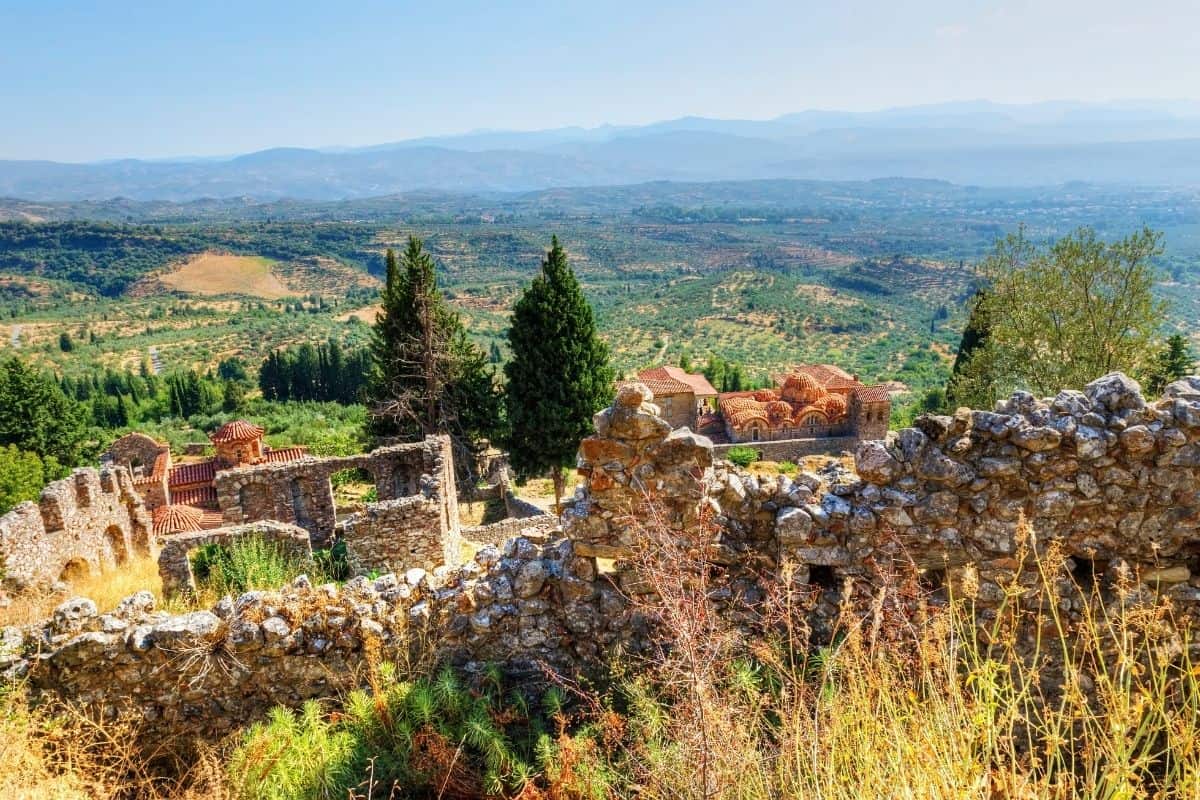
Go World Travel is reader-supported and may earn a commission from purchases made through links in this piece.
The beauty of Greece lies mainly in its contrast. This includes barren slopes and fertile valleys, steep capes and blue bays, foamy rivers and calm seas. This contrast is strong in the valley of Sparta, which Homer names, “Hollow Lacedaemona”.
Here, in ancient times, Eleni, the most beautiful of the queens in history, lived and reigned. Until she escaped to Troy with her lover Paris.
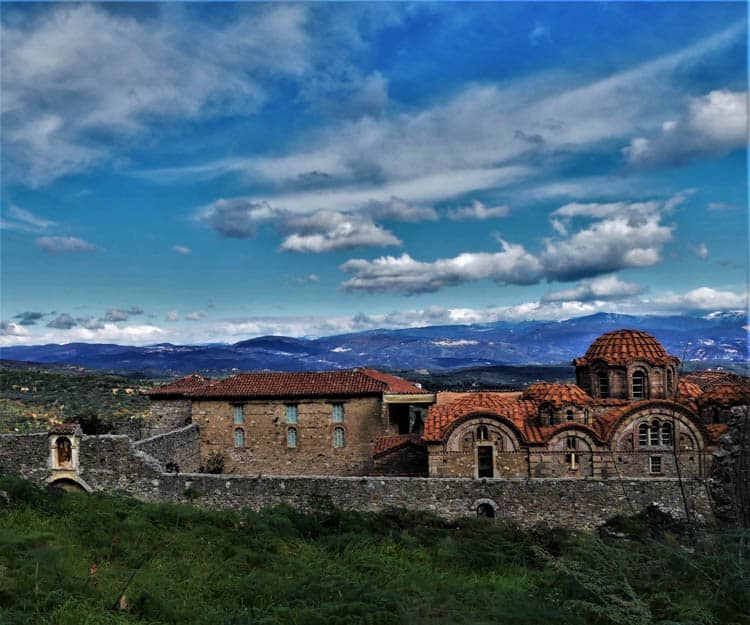
First Glimpse of Mystras
We left Sparta City to visit the Byzantine castle town of Mystras. It was December, the weather was cold, but the sun was shining. Driving the 6 km route, we saw olive and fruit trees.
Behind the valley, the Mountain Taygetos rises abruptly. It is the wildest of all Greek mountain ranges. Its five peaks, called The Five Fingers, are covered with snow until late summer.
Mystras is probably the most dramatic site in the Peloponnese, though it is a ghost town. While Constantinople was in terminal decay, the castle town became the focus of Byzantine power culture and glory. Under the Palaiologi Despots, the last Byzantine dynasty, Mystras was the intellectual centre of the Byzantine Empire.
We started climbing on the stone paths of History. At 620m the view was magnificent. In front of us stretched the ruined town and the green valley of the Evrotas river.
This was the old capital of the Despotat of Moreas. The palaces, fortifications, mansions, monasteries and churches, tell about the two centuries that its Byzantine people were living on this rock of Peloponnese.
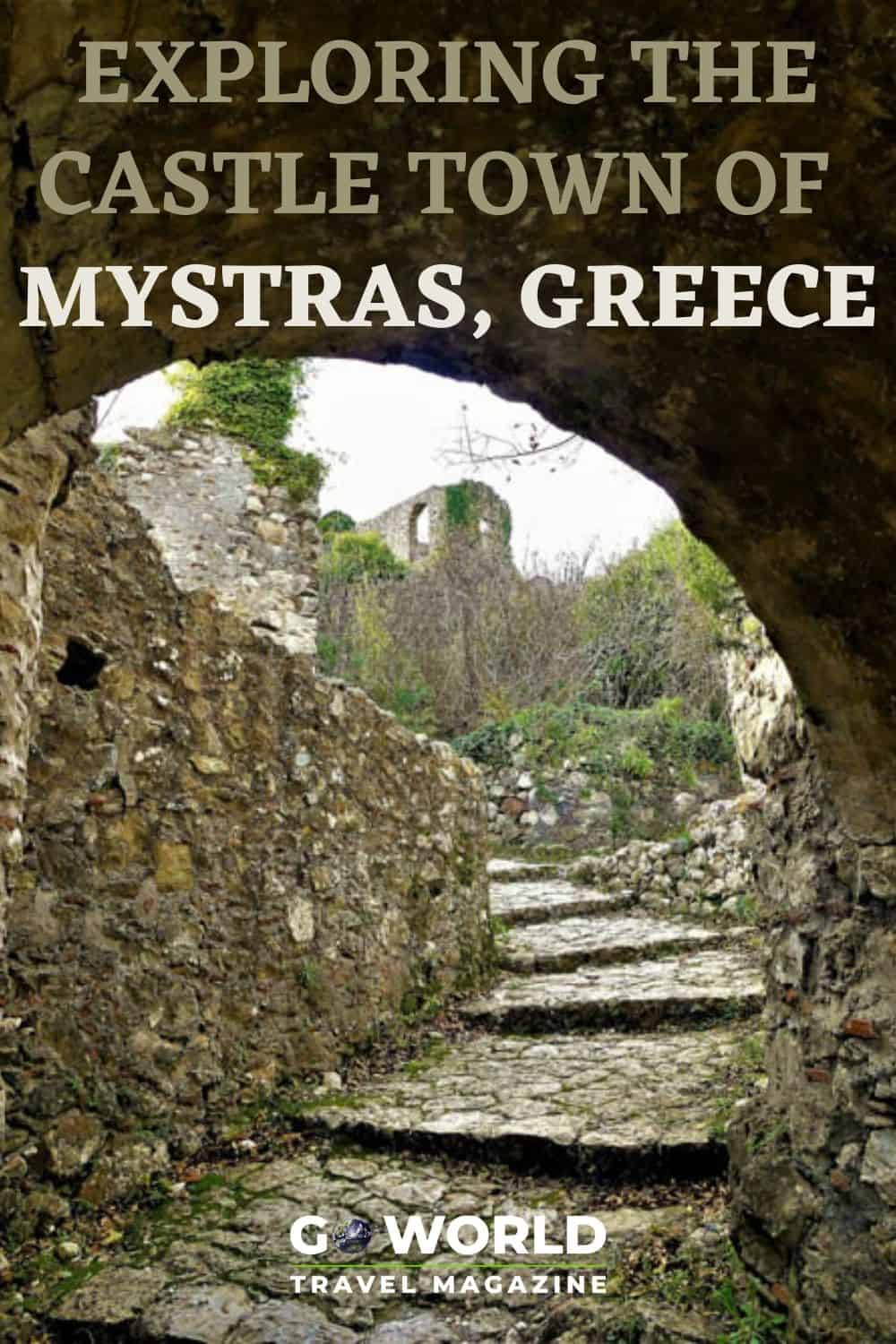
Aghia Sophia and the Gate of Monemvisia
We descended to the church of Aghia Sophia. On the north side, the church is surrounded by a restored stoa with columns from where we enjoyed the view of the plain of Sparta.
As soon as we entered the church, I looked up. A soft light came from the small windows of the dome. The sun rays of December brought warmth. The only sound was our breath.
After the church of Aghios Nikolaos, we continued to the monumental Gate of Monemvasia. At that spot, the settlement is divided into Upper and Lower Town with walls as a defensive line. For this reason, the gate is reinforced with a tower. The town was defended through the “war windows” (narrow openings in the walls and in towers.)
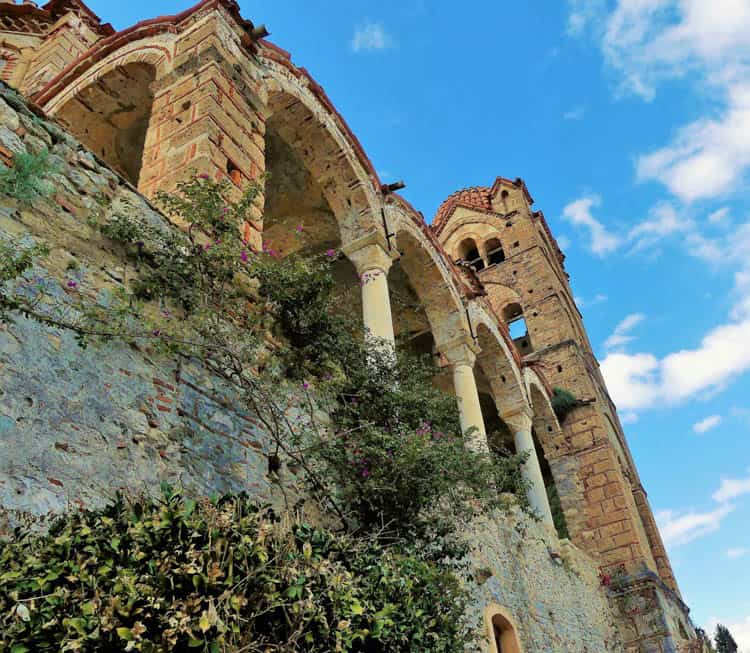
Pantanassa and Other Impressive Sites of Upper Town
In Upper Town, there are palaces and mansions, the Mitropolis Church (the Cathedral), important monasteries, residences of officials and many other houses. Passing through the imposing gate, we headed to the monastery of Pantanassa.
The benevolent nuns who live there offered us cool water. Flowerpots and two cats lying under the sun gave me a sense of calm. As the bell rang, I felt a trembling in the air.
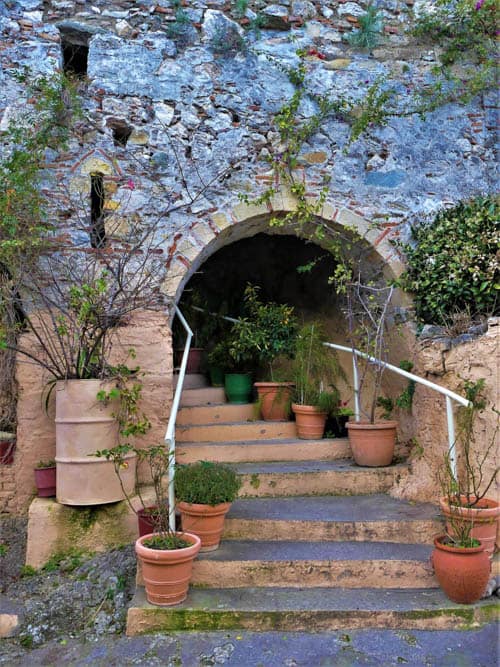
The frescoes of the Pantanassa are filled with bright colour. David Talbot Rice wrote: “Only El Greco in the west, and later Gauguin, would have used their colours in just this way.“
Two rows of walls protected the settlement that was built on the hillside, especially in spots that were easy for the enemy to approach. The walls are reinforced at intervals by square towers.
Arriving at the Perivleptos church, we observed the scalding, above the gate of the monastery. Through this, the defenders threw hot water or oil at the attackers.
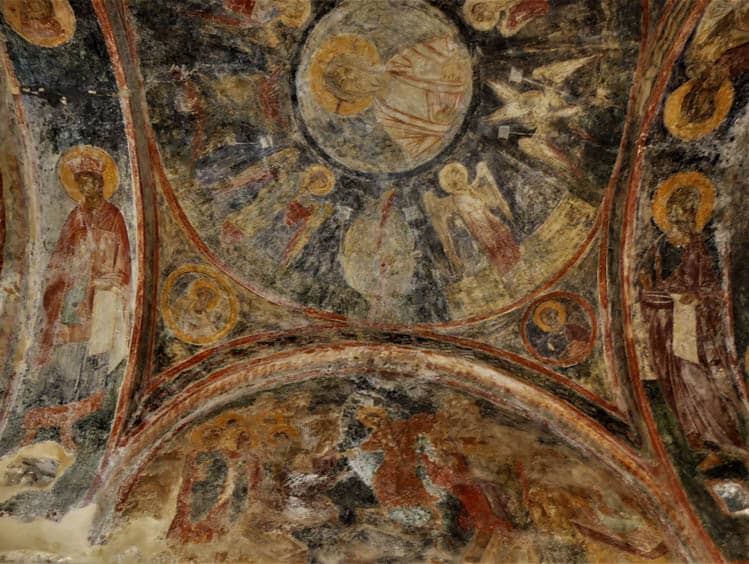
Colourful Perivleptos and Ancient Houses
Perivleptos is a domed church partially carved out of the cliff rocks. Of all the churches of Mystras, only the Perivleptos kept its painting decoration intact. The frescoes of the 14th century fascinated us.
Christ, bright and charitable, reigned in the dome in the centre of an eight-pointed star. As I stood in the centre of the church, I felt the poetic pulse and the spirituality of the painted figures.
Around us, there were ruined houses, arched openings and scattered walls. Touching the almost destroyed walls I tried to listen to the stories that happened through the centuries. Many of the stones from ancient Sparta were used to build the houses of Mystras in the 13th and 14th centuries.
For me, as History is not just a matter of dusty archives, the cobbled streets of the town were full of people. Artists, philosophers who agreed or disagreed, architects, Villardouin lords, beautiful princesses and Despots dressed in formal clothes. Or, craftsmen and villagers, who were leading their goats through narrow paths.
In Mystras there were great festivals, where the products of the Despotat were gathered: oil, honey, wine, wheat, cotton, silk.
I dreamed of a day of celebration: Women were shopping from street vendors who spread their wares on the cobbled paths. Mules loaded with oil, honey and wine were going up to the Upper Town to get rid of them in front of the rich mansions.
My thoughts were interrupted by a flutter. A hawk flew over us.
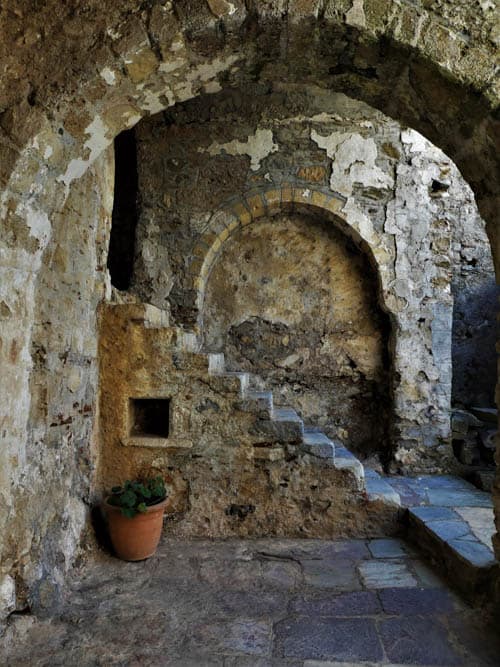
The Last Emperor of Byzantium
We entered the church where according to tradition Constantinos XI Paleologos, the last emperor of Byzantium was crowned. This, just four years before Constantinople fell to the Turks. Looking up at the interior decoration with bright colours, I saw the Holy Spirit as a sculptured bird over the pulpit.
“Do you think that the coronation ceremony really took place here?” I asked my husband Lambros.
“It definitely took place in Mystras”, he answered. Actually, Constantinos XI Paleologos was the only Byzantine emperor not crowned in Constantinople.
Continuing our exploration, we saw a majestic church, with a three-floor bell tower and chapels. It was the Odigitria church, dedicated to the Virgin Mary. The misty light coming in from the windows of the dome, allowed us to admire the preserved frescoes.
Simplicity in the composition, movement of the angels, strong and rich colour. All those were hymns to the Virgin Mary.
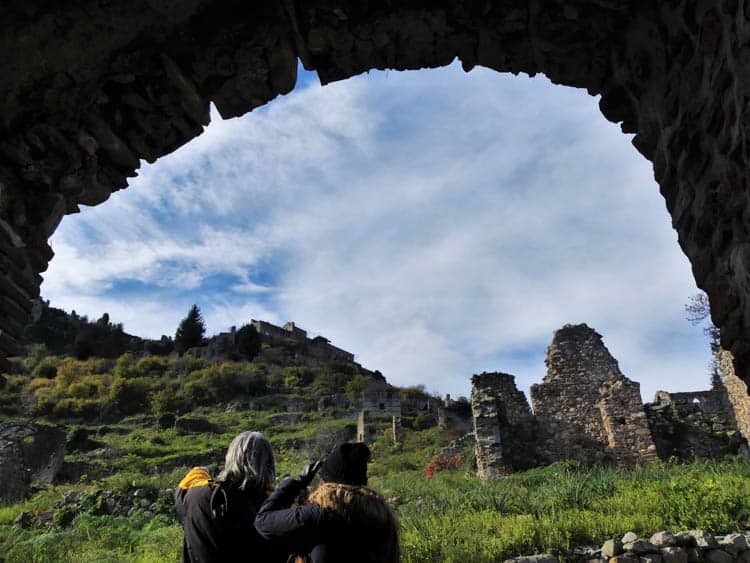
Lower Town and Reflections
Our exploration had ended leaving our minds and hearts full of images and emotions. Arriving at the exit, we wandered to the ruined houses of the Lower Town.
Looking behind me, I saw the citadel standing at the top of the hill like a sleepless guard. The time had passed, in a little while the gates would close. In the narrow corridor along the ramparts, soldiers once protected the castle town. Now, in the castle live only the six nuns of Pantanassa Monastery.
A verse I had somewhere read came to my mind…
“A Dragon-founded and dragon-built castle …”
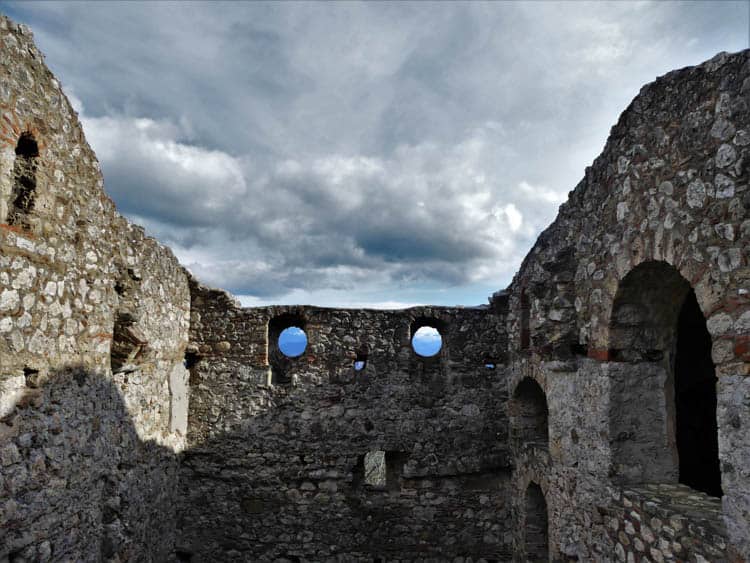
Book This Trip:
The archaeological site stands above the modern village of Mystras and the city of Sparta. The distance between the capital of Greece Athens and Mystras is 240km.
Archaeological Site https://whc.unesco.org/en/list/511/
When you plan your trip to Greece, you can find the best hotels, hostels and other living experiences through Booking.com. Then plan your route with flight deals, train tickets and car rentals through OMIO Travel Partner.
Author Bio: Lia Mageira is a Greek travel photographer and writer based in Athens. She is a holder of a degree from the University of West Attica. She focuses on Culture and History. Her work has appeared in more than 100 magazines and websites, both national and international.
- How to Get Around in Sydney: A Local’s Guide to Traveling Around Sydney - April 24, 2024
- The Low-Key Magic of Ghent, Belgium - April 22, 2024
- Discover the Hidden Charm of Extremadura in Spain - April 20, 2024
